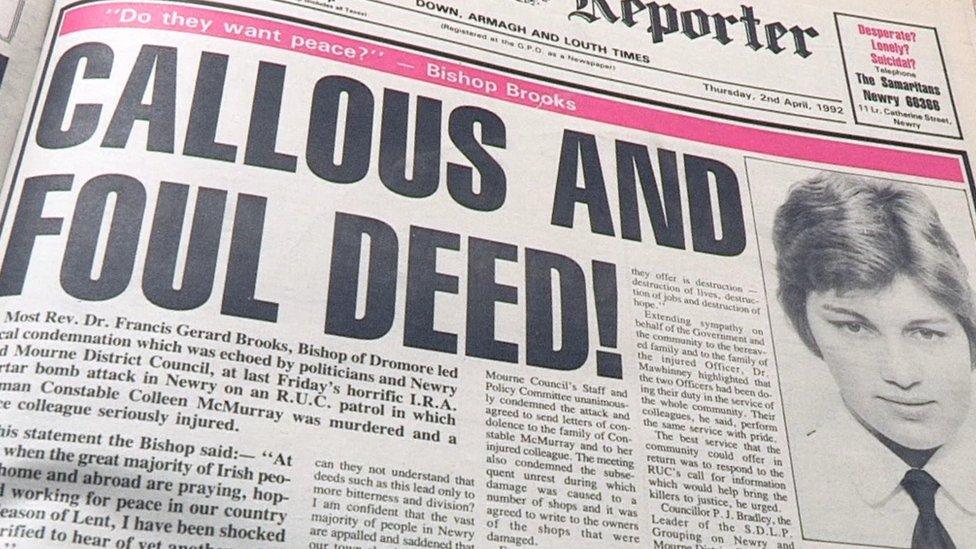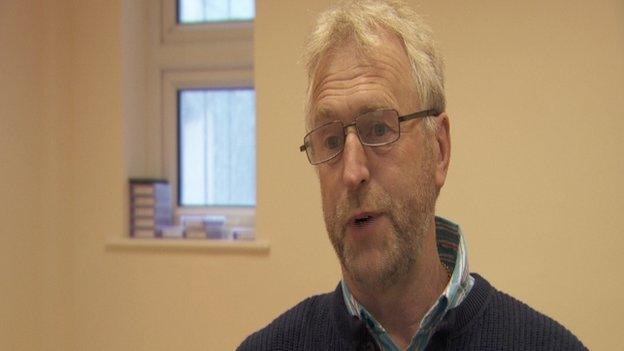Colleen McMurray: Police 'could not have prevented' officer's murder
- Published

Police could not have prevented an IRA mortar attack that killed a police constable in Newry, County Down in 1992, a report has concluded.
But the police ombudsman found there were failures in the investigation into Colleen McMurray's murder.
One of those thought to have been involved was a police informant but they were never treated as a suspect.
Her family accused the Provisional IRA and the British government of being "joint participants" in her murder.
The PSNI said it was "truly sorry" for the shortcomings the ombudsman found in the police investigation.
Ombudsman Marie Anderson says police could not have prevented the IRA murder of Colleen McMurray.
Mrs McMurray, 34, was a passenger in a police car hit by a mortar bomb as it travelled along Merchants Quay.
Her colleague, Paul Slaine, survived, but lost both his legs.
Mrs McMurray's family said she "served all the communities without fear or favour and knew the risks involved in being an RUC police officer at that time" but they "strongly contend" that her murder could have been prevented.
They are calling on Northern Ireland Secretary Brandon Lewis to establish a judge-led statutory inquiry into the murder as soon as possible.

Days after the murder, the bishop of Dromore led condemnation of the attack in the Newry Reporter
The ombudsman's office has been looking into the case since 2004, external.
Its investigators interviewed more than 90 witnesses, included 35 retired police officers.
The report said the original Royal Ulster Constabulary (RUC) investigation was undermined by its own Special Branch division, which did not provide information about potential suspects.
This included Person A, an IRA member who had been recruited as an informer shortly before the attack.
He was regarded as an explosives expert and was involved in the development of the technology used to trigger the mortar using a photographic flashgun.
Person A later claimed publicly that he had provided his handlers of prior warning of the attack.

Mrs McMurray and her colleague Paul Slaine were in a police car when it was hit by a mortar bomb
However, having assessed the intelligence evidence, ombudsman Marie Anderson is "of the view" that he gave no information which "could have prevented or forewarned of" the attack.
She added: "(RUC) Special Branch had significant intelligence about Person A's possible role in the development of the detonation technology and possible links to previous IRA activity.
"In my view, he ought to have been treated as a suspect but I have not been able to identify any legitimate reason why this did not happen."
PSNI sorry for investigation shortcomings
Ms Anderson said her report identified further investigative failings.
They included "deficiencies in suspect and arrest strategies".
Although a number of arrests were made, no individuals have ever been made amenable for constable McMurray's murder.
PSNI Assistant Chief Constable Mark McEwan apologised for what the police ombudsman identified as "shortcomings in the handling of information and the subsequent police investigation".
"As we have previously stated the practice and policies that govern intelligence matters and police investigations today are unrecognisable from what was in place at the time of the attack.
"I acknowledge the fact that the ombudsman has recognised this in her report.
"I also acknowledge that the ombudsman has recognised the operating context at the time; the lack of a legislative framework and the operational dangers faced by police officers serving their community."
He added: "Sadly it remains the case that no person has been brought to justice for this terrible crime and today, with the publication of the police ombudsman's report, when details of this brutal attack are fresh in people's minds, I would make a renewed appeal for the people who know who did this to come forward to us with information."
Mrs McMurray's husband, Philip, and her family said that the 17-year wait for the report has compounded the family's grief.
Philip McMurray said he was left feeling "betrayed"
"The findings in this report, whilst welcomed in part, do not go far enough. It is clear that Special Branch held intelligence on key suspects involved in the murder of Constable McMurray.
"The families are of the view, because there was collusion between the PIRA and British Security Forces which is politically difficult for both the Provisional IRA and the British state to allow to be investigated."
'The need for answers is unquestionable'
DUP leader Sir Jeffrey Donaldson welcomed the report but said that "further questions remain".
"This was a brutal PIRA [Provisional IRA] murder which robbed a family of their daughter and a husband of his wife. They had been married for just 18 months," he said.
"It also left Paul Slaine seriously disabled for the rest of his life, having lost both his legs in this mortar attack.
"The need for answers is unquestionable given what both families have endured."
Sir Jeffrey said he understood why the family would call for a judge-led inquiry, and said that victims' "access to justice must never be closed down".

Analysis: Report points to established pattern
If this was a one-off report then it would be more shocking, but it falls within what has become an established pattern around the murky world of intelligence gathering and the use of agents during the Troubles.
There will be many people that feel that the PSNI, because of its historical relationship with the RUC, are not well positioned to conduct historical investigations into these crimes.
These crimes remain unsolved, and in any other society would need full investigation.
Of course, we know that the government is advancing legacy ideas that would close down all investigations and all prosecutions.

Related topics
- Published17 June 2015
